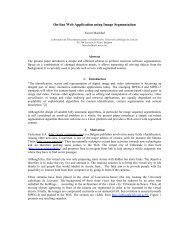motion estimation and compensation for very low bitrate video coding
motion estimation and compensation for very low bitrate video coding
motion estimation and compensation for very low bitrate video coding
You also want an ePaper? Increase the reach of your titles
YUMPU automatically turns print PDFs into web optimized ePapers that Google loves.
Conclusion<br />
With the emergence on the market of <strong>low</strong>-cost cards al<strong>low</strong>ing customers<br />
to decode the ISO MPEG-1 <strong>and</strong> MPEG-2 st<strong>and</strong>ards, digital <strong>video</strong> <strong>coding</strong><br />
is becoming a <strong>very</strong> common functionality ofmultimedia personal<br />
computers. For several years, <strong>video</strong> <strong>coding</strong> has moved towards <strong>very</strong><strong>low</strong><br />
<strong>bitrate</strong>s (under 64kbits=s). A major result of this trend is the ITU<br />
H.263 st<strong>and</strong>ard which also has the advantage that the software version<br />
of its decoder per<strong>for</strong>ms in real-time on a PC. The future ISO MPEG-4<br />
st<strong>and</strong>ard goes one step further as it o ers the possibility to the user to<br />
somehowinteract with the contents of the pictured scene. Because of the<br />
convergence of the target <strong>bitrate</strong>s with the ever-increasing capabilities of<br />
existing networks, some people already claim that these two st<strong>and</strong>ards<br />
are putting an end to research in \pure" <strong>video</strong> <strong>coding</strong>.<br />
Among the tools used to achieve compression of the <strong>video</strong> signal, <strong>motion</strong><br />
<strong>estimation</strong> is probably the one o ering the greatest compression ratio. A<br />
lot of research has been devoted to it during the last two decades. It not<br />
only resulted in great outcomes in <strong>video</strong> <strong>coding</strong> but also in other elds<br />
where <strong>motion</strong> analysis plays a key role, like semantic interpretation or<br />
target tracking. The exploitation of <strong>motion</strong> in a <strong>video</strong> <strong>coding</strong> scheme<br />
typically involves three steps: <strong>estimation</strong>, transmission <strong>and</strong> <strong>compensation</strong>.<br />
The <strong>video</strong> <strong>coding</strong> context <strong>and</strong> the state of the art in related <strong>motion</strong><br />
<strong>estimation</strong> techniques have respectively been presented in Chapter One<br />
<strong>and</strong> Chapter Two. Some emphasis was put on the <strong>very</strong>-<strong>low</strong> <strong>bitrate</strong><br />
environment <strong>and</strong> on the most used <strong>motion</strong> <strong>estimation</strong> techniques (BMA<br />
<strong>and</strong> warping techniques). In this sense, the present thesis contributes to<br />
the investigation of the possibility to enhance the various steps of the<br />
<strong>motion</strong> chain by somehow taking into account the spatial contents of the<br />
image(s).<br />
Chapter Three modi es the <strong>estimation</strong> per<strong>for</strong>med by a classical BMA





